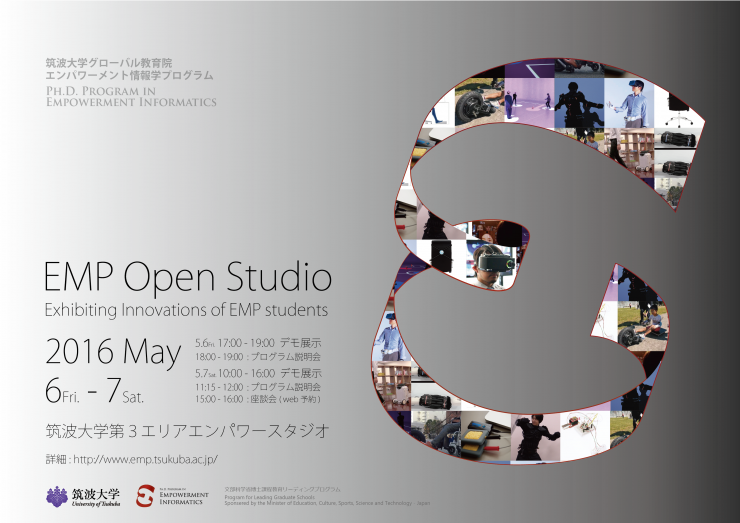2016年5月6日(金)17:00 – 19:00、7日(土)10:00 – 16:00:エンパワースタジオ:EMP Open Studio 2016 開催のお知らせ
EMP Open Studio 2016 開催のお知らせ
EMP Open Studio 2016 概要
エンパワーメント情報学プログラム(EMP)では、プログラム紹介及び入試説明会を兼ねた研究成果発表会「EMP Open Studio 2016」を開催します。当日は、EMP学生が自主的に取り組んでいるプロジェクトの展示発表や本プログラムの説明会、在籍生との座談会(事前登録制)を実施致します。どなたも奮ってご参加ください。
プログラム
日時:
2016年5月6日(金) 17:00 – 19:00
2016年5月7日(土) 10:00 – 16:00
会場:
筑波大学 第3エリア エンパワースタジオ
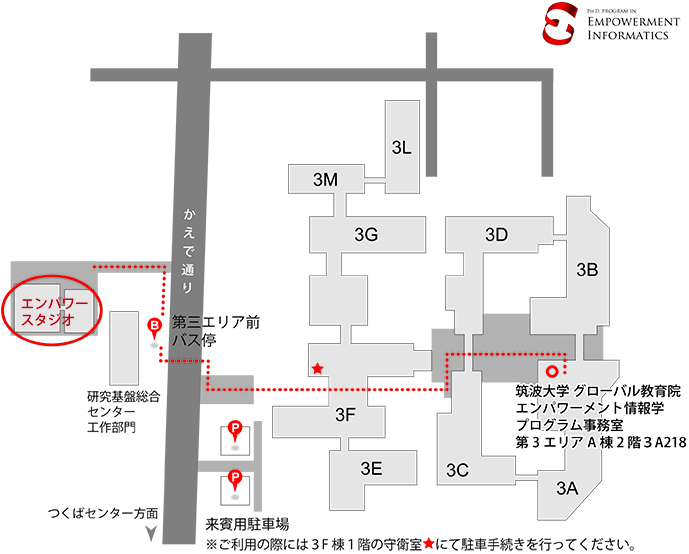
スケジュール:
| 2016年5月6日(金) | |
| 17:00 – 19:00 | 作品展示 |
| 18:00 – 19:00 | プログラム説明会 |
| 2016年5月7日(土) | |
| 10:00 – 16:00 | 作品展示 |
| 11:15 – 12:00 | プログラム説明会 |
| 15:00 – 16:00 | 座談会 |
座談会登録( 参加費無料 ) : http://goo.gl/forms/uDgr5SdWq5
お問い合わせ
EMP Open Studio 2016 Committee: exhibition.committee@emp.tsukuba.ac.jp
Committee Member:
江國 翔太 / Shota Ekuni:Project leader
村田 耕一 / Koichi Murata
朝倉 靖成 / Yasunari Asakura
佐藤 晃矢 / Koya Sato
ISHAC Karlos
利根 忠幸 / Tadayuki Tone
展示作品紹介
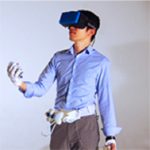
CHILDHOOD
本作品は自身の視覚・触力覚を子供のそれに変換することで、大人が子どもの身体を体験することができる身体性変換スーツです。 手指の把持動作を縮小する受動型手指外骨格と、HMDとカメラベルトを使った子供目線の視点を再現する視点位置変換デバイスを装着することで、小児の身体性を体験することができます。 空間のアクセシビリティやユーザビリティ評価や、医療従事者のアウェアネスを支援する取り組みを実施しています。
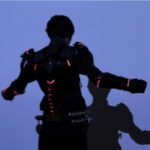
Cyber Protection Suit
人工筋肉が持つ剛性と弾性により身体を強化し、あらゆる衝撃から身体を防御することを目的とした全く新しい装着型防御システムです。本システムは装着者の防御意思に基づいた随意的な制御をおこなっており、非防御時の機動力を低下させることなく防御機能を拡張することができます。人工筋肉に強化繊維などを用いることで斬撃や銃撃に対する防御にも応用できる可能性があります。
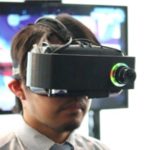
Bionic Scope
我々は、人間の生体情報を利用して中心視野領域を直感的にズームする「視覚機能拡張インターフェースシステム」を開発しました。装着者が目を細めて凝らす動作や奥歯を噛む動作などを行った際に、目の周辺に発生する生体電位信号をセンサにより検出し、それと同期して中心視野領域をズームします。本システムにより、装着者はハンズフリーで、現在向いている方向の映像を直感的にズームすることができ、常人の視力の領域を遥かに超えた視覚を体験することが可能です。
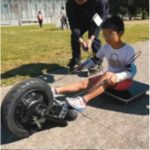
CarryOtto
テクノロジーにより身体能力を拡張させ、身体差を超えることで誰でも参加可能な”超人スポーツ”。CarryOttoは古代ローマ時代のチャリオットレースにインスパイアされて開発されたもので、インホイールモータを手綱で操作する全く新しいスポーツです。このスポーツは年齢、性別、体力・体格差、車いす搭乗者、障がいの有無を問わず、誰もが参加できるようにデザインされているため、皆が同じフィールドで競い合うことが可能です。本スポーツの普及により、多くの人の運動参加を促進することができ、近年社会問題となっている運動不足を解決するための手段となるだけでなく、社会交流の促進や障がいの理解へ繋がると期待されています。
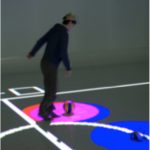
Sports Support System
本研究の目的は様々なプレイヤーの能力の差を補完するシステム、Sports Support System (SSS) の開発です。スポーツには健康面によい影響があり、スポーツを通して精神的、感情的、身体的な部分で恩恵を受けることができます。さらに、チームスポーツに参加することで新たな出会いが生まれ、社会での生活を豊かにすることができます。対戦型のスポーツでは、戦略や反射神経などのスキルはゲームを有利にするために重要であるが、初心者と上級者の間には大きな差が存在します。そこで、SSSは様々なプレイヤーの能力の差を補完し、既存のスポーツを拡張して新たな形のスポーツや体験、楽しみを生み出すことを目指します。
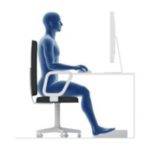
LifeChair
With LifeChair any chair can become a smart chair. It is personalized to its user and aims to track and improve their working lifestyle to reduce stress, elevate their mood and increase productivity. LifeChair uses vibrational feedback to actively correct the user’s posture when they are slouching or reclining. In this manner, sitting upright becomes intuitive. The LifeChair also regulates the seating time and water intake of the user through interval notifications via the LifeChair smart phone app. Through a specialized neural network we have constructed a model for upright sitting posture. The energy expenditure of upright sitting has been proven to use up to 60kj more when compared to slouching. Based on this, when you use LifeChair to sit upright, you are toning your core, back and upper leg muscles as you burn up to 20% more calories at your desk. LifeChair is clever comfort for a smarter life.

Levitas
Levitas aims at exploring a new type of movement control interface for 3D spaces. By using a combination of electrophysiological signals and active commands, it allows people to flight around a large space. The two proposed modalities are similar to breathing. Whereas electrophysiological signals are passive and automatic, active commands are consciously activated by the user. These embodied interactions enable people to take the role of a magician flying to explore a virtual environment.
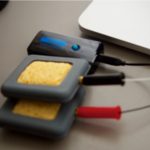
tDCS
Transcranial direct-current stimulation (tDCS) has been known as it activates or deactivates our brain activity. It means that this device can accelerate or inhibit our brain ability. In this project, I focus on the brain acceleration ability of this device, and I am trying to reinforce our visual recognition ability. My final goal is following condition: we can see the object in the display that we can’t see without tDCS. In this demo, I show the progress of this research.
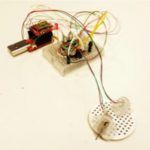
Ultra small moving robot
Tiny robot that can be put on your hand. By now, we do not have any platform for tiny, fast to run, and inexpensive mobile robot. If we need it, we should make it by ourselves. This project helps people those who need this kind of robots. The robot under development is designed to be tiny, inexpensive and easy to use as it is Arduino-compatible. Moreover, it has Bluetooth connection and AD/DA conversion ability so that it can be used for many applications.

Kamebo
近年、世界規模で急激な高齢者人口の増加が進んでいます。一般的に認知症の発症は年齢の上昇に伴う場合が多いと考えられ、現在の認知症人口は約4700万人と推定されています。認知症が進むと、高齢者の多くが記憶障害や認知障害によって日常生活を他者へ頼らざるを得ず、自立的活動が困難になるケースが増加します。Kamebö は声や動きのガイドにより、認知症高齢者が希望する場所への移動を可能にします。また、投薬時間に甲羅内のピルケースが自動的に開き、高齢者が適切な時間に薬を飲む事ができるように支援しています。この人工知能を備えた移動支援ロボットを活用することで、認知症高齢者がより自立し活動的な生活を送ることができると考えています。
Mimicking sense of touch (Kani Kabuko)
Kani Kabuko installation consists of 3 parts; a Kani VR helmet, a small underwater robot KaniTe and a tele-operating haptic system.
Participants are invited to wear a specially designed Kani VR helmet on his/her head, which replaces his/her visual and audio experience with the small underwater robot KaniTe in a fish tank. KaniTe robot is equipped with a small 360˚ waterproof camera from which a real time video footage and sound are sent to the Kani VR helmet.
Vision may provide the majority of our sensory input, but touch is the key to building this thoroughly believable illusion. Viewed from phylogenetic and ontogenetic perspectives, the sense of touch plays a relatively central role in relation to the other senses. KaniTe is tele-operated with a specially designed haptic system. A participant can manipulate the underwater KaniTe robot with just two fingers. VR is capable of manipulating the senses to the point of creating a mental sensation of being in the body of another. Under the right set of conditions, the mind can be tricked into believing that it is feeling the sensations that the external/another body feels. To achieve a convincing immersion in the Kani Kabuko project we have created a Kani VR helmet which is equipped with KaniTe legs on the surface. They produce a crackling sound. In the inside of the helmet we have installed motors which provide the participant with the sensation of moving of the KaniTe robot legs.
The whole mobility experience of the underwater KaniTe robot is actually transmitted to the Kani VR helmet.
The setting is carefully arranged by the artists, but the content of the experience is up to the participants.
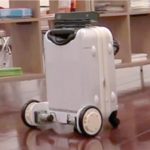
Trolley Case Robot: Panther
Pantherはユーザーを支援するキャリーケース型ロボットです。このロボットにはモータが内蔵されており、ユーザーの動きに合わせてアシストするため、重い荷物も少ない力で運ぶことができます。我々は現在、2種類のロボットを開発しています。一つは、デプスセンサによってユーザーおよび周囲の環境を認識する完全追従型ロボットであり、もう一つは、本体の角度を検出して、傾いた時にだけ駆動するアシスト型ロボットです。Pantherのユーザーは健常者だけでなく、高齢者や車椅子使用者も想定しており、今後ますます介護が重要となってくる我が国において、介助者を代替する手段にもなることが期待できます。



